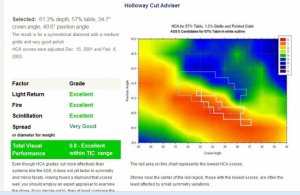L
Lula
Guest
Adrienne2006|1367972809|3442375 said:Lula,
Thanks for the link you posted. Could you tell me the names of what each diamond is called in the article (60/60, Bic, HOF,Tic)? For example my eye went straight to No. 6 as the most beautiful to me, as I scrolled down to the numbers it sounded like a PS Diamond : ) Is No. 6 called a specific name? This adds a new dimenson to people's searches. Thanks!
You're welcome, Adrienne. I've attached the chart from the article that lists the "makes" of each of the diamonds in the fifth column, entitled "Make". Make is another term for diamond cut parameters.
"NT," which is what diamond #6 is, stands for "Near Tolk" or Near Tolkowski cut. Tolkowski ideal cut parameters are the cut parameters preferred by most Pricescope members for round brilliant diamonds. These diamonds are referred to as "TIC" or Tolkowsky Ideal Cut diamonds by the Holloway Cut Advisor (HCA).
"S/D" stands for "Steep-Deep," which are very common, and are easily found in mall jewelry stores and other mid-range jewelers. These diamonds have higher crowns and deeper pavilions (when compared to Near Tolk diamonds).
"60/60" refers to diamonds cut with a 60% table and 60% depth.
The HCA labels diamonds with shallow crowns and shallow pavilions as "BIC" diamonds, which stands for Brilliant Ideal Cut (compared to Near Tolk diamonds). The HCA labels diamonds with higher crowns and deeper pavilions as "FIC" diamonds (compared to Near Tolk diamonds), which stands for Firey Ideal Cut.
Each of these categories represents a range of numbers, so slight variations in the numbers can produce a beautiful BIC or TIC or FIC or 60/60,or a not-so-pretty stone. Each of the cut styles has a different personality. That's why I believe it is impossible to buy diamonds by the numbers; diamonds need to be evaluated in person under a variety of all lighting conditions, and its imperative that there is a good return policy in place. The best way to determine what "make" you prefer is to look at a lot of diamonds in person. Compare, compare, compare.
John Pollard, the author of that article, posts on Pricescope; he may have much more to say on this topic. I'm just skimming the surface here





300x240.png)